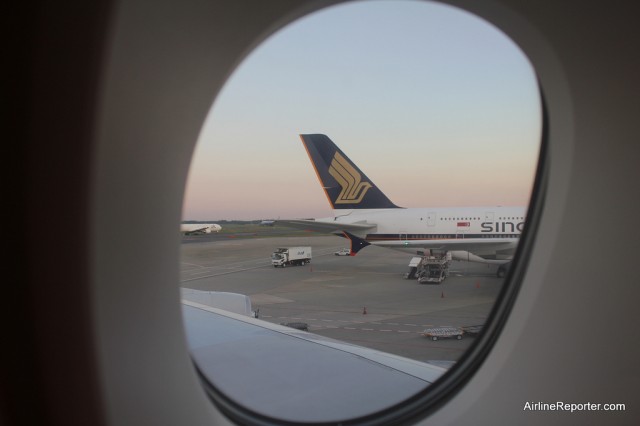“If it bleeds it leads” — a nice classic saying of writing sensational stories to get more traffic.
When I first heard of small cracks being found on Qantas and Singapore Airlines A380s I read up on it and found it to be a non-issue and not really worthy of writing a story. The majority of media covered it the way that they should — that cracks were found and they are no big deal. Some examples:
Toronto Star by Lesley Ciarula Taylor:
‘Non-critical’ cracks inside wings of Airbus A380 spark grounding call
ATWOnline by Geoffrey Thomas:
Minor cracks found in Qantas A380 wings pose no safety threat
Reuters by Harry Suhartono and Narayanan Somasundaram:
Singapore Air, Qantas say cracks found in Airbus A380 wings
USA Today by Ben Mutzabaugh:
Cracks found on A380 wing parts called ‘non-critical’
Then I start seeing more and more sensational headlines that were very misleading and it started to frustrate me. They acted like planes were going to start falling out of the sky and everyone needs to panic. Some of those examples:
Daily Mail by Rob Waugh:
World’s biggest super-jumbos must be GROUNDED, say engineers after cracks are found in the wings of three Airbus A380s
– Wow, even capitalizing the word “grounded” — classy.
CNET by Edward Moyer:
World’s largest passenger plane may be unsafe, some say
– I love the “some say,” it doesn’t really matter who, just some people are saying it and we are reporting it.
Gizmodo by Jamie Condliffe:
Airbus Refuses To Ground A380s Despite Cracks In Their Wings
– Or, they might refuse to ground them, because they do not need to be grounded.
BBC News by Tim Allman:
Airbus A380 fleet should be grounded, say engineers
– Well if engineers are saying it, then it has to be true.
What interests me is that those “some say,” and “engineers” all turn out to be the same one person in all these stories…
“We can’t continue to gamble with people’s lives and hope they make it until their four-year inspection,’ said Steve Purvinas, federal secretary for the Australian Licensed Aircraft Engineers Association.
What almost all the news sources do not say is that Purvinas’ organization has been fighting against Qantas’ decision to outsource maintenance jobs. Interesting huh? It would seem to me that this guy and the ALAEA might have an agenda.
Safeskies (an organization specializes in airline safety) chairman David Forsyth stated that, “I doubt the ALAEA union which made the comments, is technically trained or qualified to argue against Airbus structural design engineers about cracks in their aircraft. Airbus will investigate these cracks and promulgate an inspection program, agreed by the safety Regulators.” He continued with, “Using safety as a weapon in IR disputes, without reasonable grounds, is like the boy who cried wolf. Repeated ad nauseam, the impact will lessen over time, and if eventually there is a valid safety issue, it might be dismissed as just another rant.”
Airbus has confirmed the cracks, but stated that they are not a safety issue. “We have traced the origin to a material-related manufacturing issue and developed an inspection and repair procedure which will be done during routine, scheduled, maintenance checks. This is not a safety issue. Aircraft performance is not affected. Any fix, if necessary, can be done during regular (4 year) maintenance.”
Every single airliner ever build has had issues that do not affect safety. Aircraft manufactures issue thousands of service bulletins and the huge majority of them are very minor.
This really is a non-story that should have never received much coverage outside airline trade journals. Yet, it was too tempting for some journalists and their editors to write that an engineer stated that the fleet of A380s should be grounded. The airline business is a disproportionately mis-represented business already and stories like this do not help the situation.

I would do a bit of checking on Mr DAVID FORSYTH, EX AIRCRAFT OPERATIONS, QANTAS. Before I took his word as gospel I think he is the same guy involved in staple fiasco.
regards
Davo
This is a blog! There is no place for critical thinking here!!!
😉
So instead of taking the word of Mr Forsyth you could instead take the word of the company that employs highly qualified people to carefully analyse the problem and come up with a recommendation. The same company that will suffer a fatal blow to their reputation, not to mention huge civil lawsuits and possibly criminal charges if they say a problem is not a safety-of-flight issue when it is. The company that employs people who will face manslaughter charges if they are wrong about a statement like this.
Critical thinking is definitely a good thing. In this case I would suggest some of it be used to find out more about how metal fatigue works. Then it should be obvious why discovering minute cracks in a non-critical component is really not a big deal.
In fact I can practically guarantee you that any plane you have flown in that was more than a year old will have fatigue cracks in it somewhere. Fortunately we now know enough about metal fatigue to be able to predict when cracks will pose a threat to safety (which can take decades of flying in many cases) and devise inspection and repair schemes accordingly.